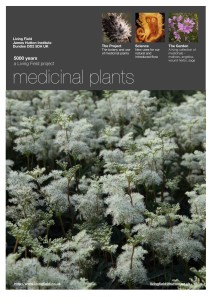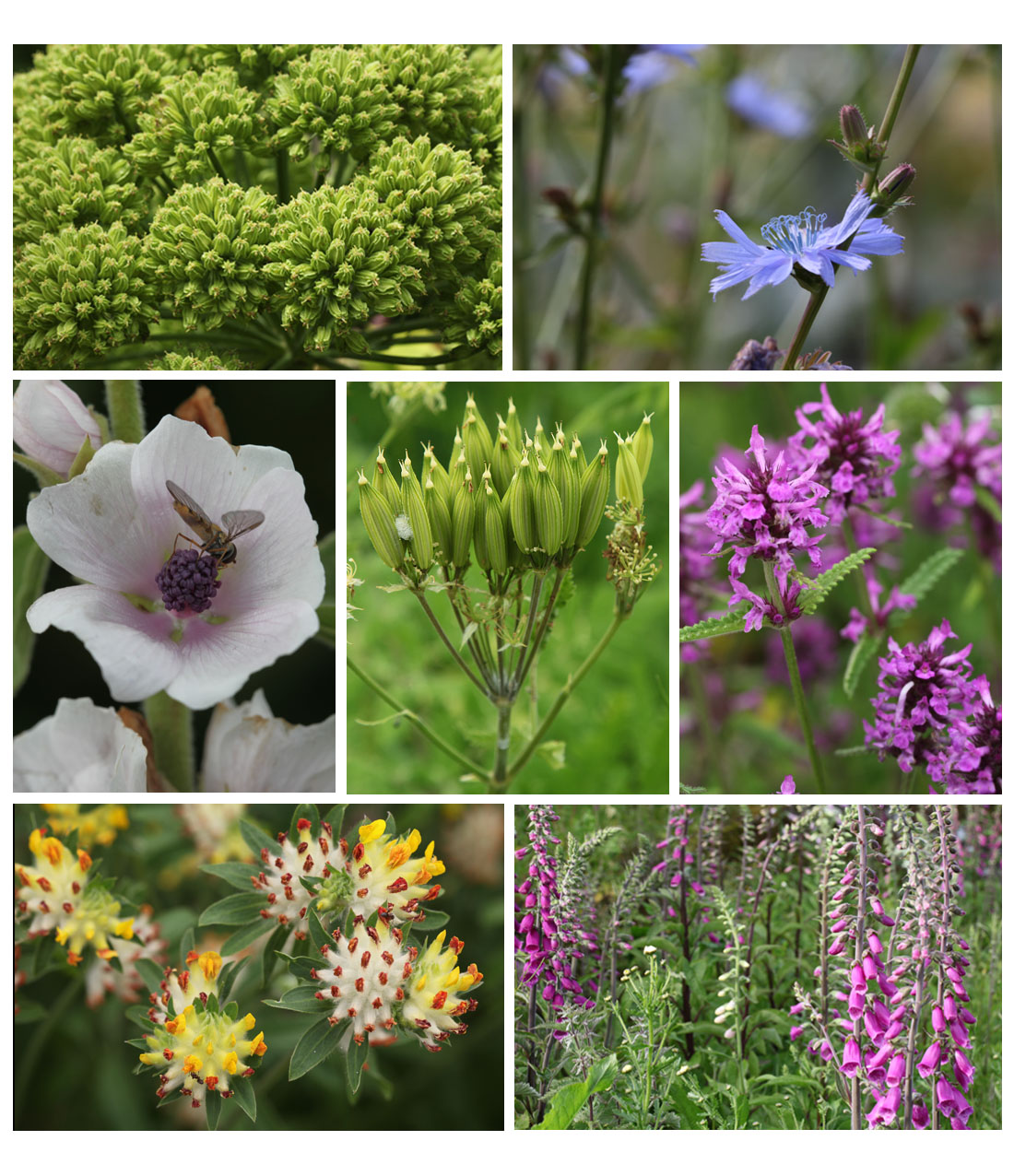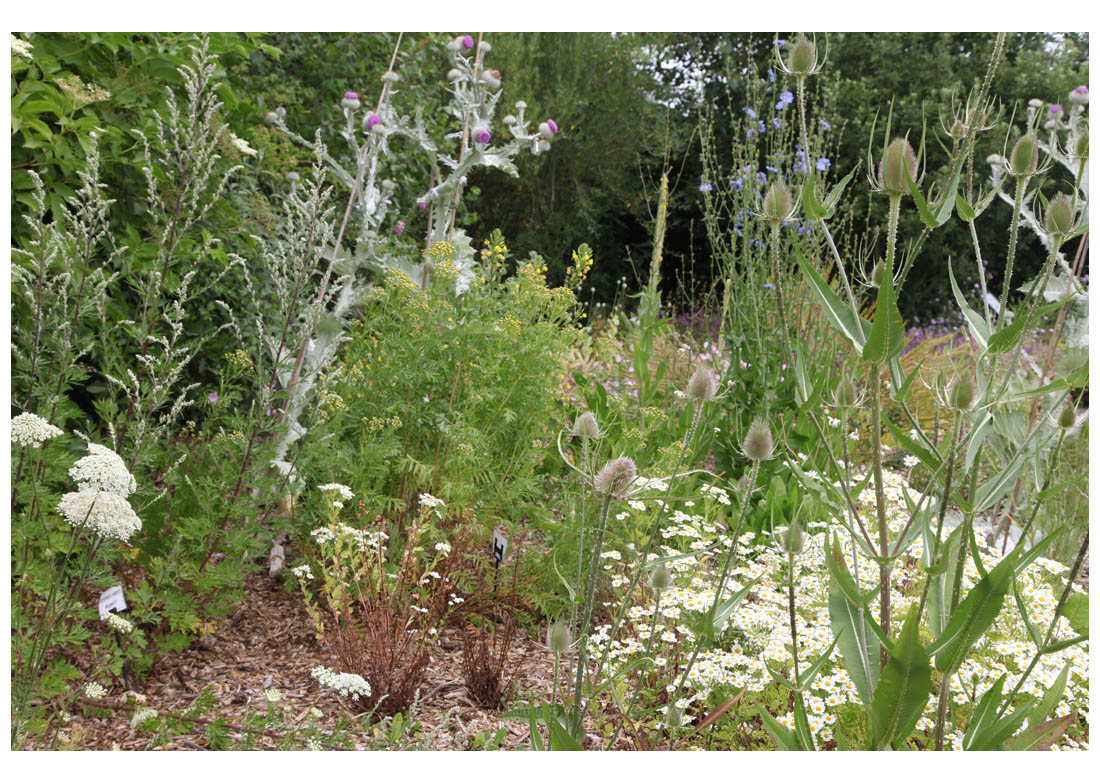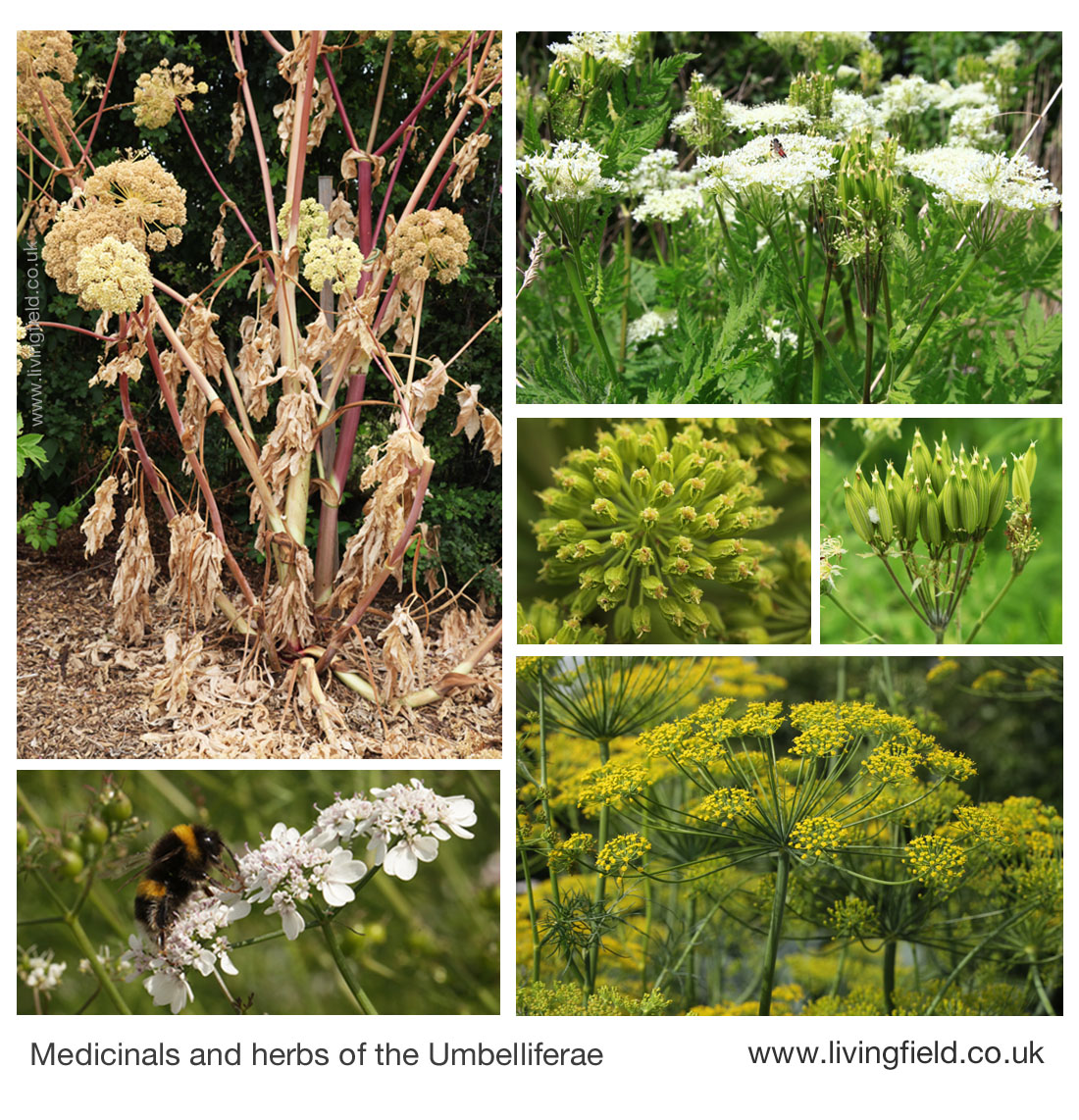
Plants used to cure ailments, promote health or to flavour food have a long history, predating the arrival here of the first cereals from the mainland.
There has been an immense knowledge of these plants, gained by experience, and passed between generations, and which is still retained and transmitted in this way in many other cultures, but now rarely in our own.
Experimenting with plants over the millennia must have led to experiences that were sometimes uncomfortable, or worse for those that can be medicinal, narcotic or poison depending on the dose and preparation. The Living Field grows a range of medicinals and herbs for their botanical and historical interest, but except for the culinary herbs, does not use the plants or explore their medicinal properties.
In many places in the world, herbs as salad vegetables or flavourings are collected for the daily pot, but few people here seek out plants such as ground elder, chervil, caraway and nettle simply to eat them. Yet in times of serious privation, gathering the wild harvest has saved the nation, as in the organised collection of rose-hips for their Vitamin C.

While medicinal herbs have been associated more with the monastery garden, or its equivalent through the ages, some have been grown as broadacre crops in fields at various times. The croplands here has no equivalent of the lavender fields of mediterranean Europe, but herbs such as parsley, fennel and even coriander are even now cropped in season. Herbs are also grown commercially for use in cosmetics and ‘herbal remedies’.
Hardly without exception, plants that people have found to have uses beyond food, are prime food plants for insects, whether boring into stems, despoiling flowers or chewing seed. Each year the medicinals are a feast for the Garden’s many small animals.

The plants are grouped below in their families.
Rose Rosaceae Not only the wild roses, thorns, berries and cherries in the hedges, but also meadowsweet Filipendula ulmaria in the ditch, and lady’s mantle Alchemilla mollis, wild strawberry Fragaria vesca and agrimony Agrimonia eupatoria together the medicinals bed.
Mallow Malvaceae The three mallows – marsh mallow Althea officinalis, musk mallow Malva moschata and common mallow Malva sylvestris are all perennials that yield variously poultices, ointments and the base of sweetmeats (marshmallow). The marsh mallow is rare in the wild here, the other two not so. The mallows are not just useful to people … look at any mallow flower and there will be an insect. The mallows are easy to grow: the marsh mallow fades away over winter, but keep the ground above it clear of weeds and debris and it will sprout late and flower late; the common mallow tends not to last too long in one place and fades away from competitive grasses and rank weeds, so transplant it often; the musk mallow usually copes with dense vegetation.
Poppy Papaveraceae The opium poppy Papaver somniferum, spectacular when flowering in mass, usually self-seeds, but is planted each year from seedlings. The source of painkillers but also narcotics. The greater celandine Chelidonium majus – a short-lived perennial of the same family and nothing like the lesser celandine (a buttercup) – oozes an orange-yellow, latexy stain when damaged. The red-flowered poppies appear most years in a disturbed space.
Carrot family Apiaceae, previosly known as Umbelliferae. Flowers are born on structures called umbels, of the same general form, but of great variety among species. There are several of them flowering and fruiting in the garden each year: lovage Levisticum vulgare, the massive garden angelica Angelica archangelica, fennel Foeniculum vulgare, sweet cicely Myrrhis odorata, dill Anethum graveolens and parsley Petroselinum crispum. A family yielding a very wide range of useful medicines and tastes; many species smelling of aniseed or carrot. The wild carrot itself is described on the ‘meadow’ page.

Cabbage Brassicaceae (Cruciferae) Though a prime food, the cabbage family offer few species grown for their medicinal properties. The wild cabbage Brassica oleracea, a plant restricted to coastal cliffs in the wild (but tried in the garden 2014) has long been used as such (Grigson) while shepherd’s purse Capsella bursa-pastoris is still sold as a dried herb in eastern Europe. Perhaps the best known for its medicinal properties is scurvy grass Cochlearia officinalis (not in the garden at present) the juice of which gives Vitamin C.
Dead-nettle Lamiaceae (Labiatae) The Labiates include that great array of herbs known for cooking and scenting – sage, rosemary, thyme, mint and lavender, but which also yield oils and other extracts. In 2014, the Garden has sage Salvia officinalis, rosemary Rosmarinus officinalis, hyssop Hyssopus officinalis, garden thyme Thymus vulgaris, lemon balm Melissa officinalis, wild marjoram Origanum vulgare, betony Stachys officinalis, the foul-smelling hedge woundwort Stachys sylvatica, marsh woundwort Stachys palustris and various mints (species of Mentha).
Among others of the labiate family, a patch of white dead-nettle Lamium album survives and flowers each year just left of the medicinals bed, ground ivy Glechoma hederacea lives under the trees and a calamints (species of Clinopodium) appeared one year and was back, flowering and seeding, as two plants in 2014. As ‘weeds’ growing here and there, red dead-nettle Lamium purpurum, henbit dead-nettle Lamium amlexicaule, large-flowered hemp-nettle Galeopsis speciosa and self-heal Prunella vulgaris give added interest.
Borage The borage itself Borago officinalis is an annual, sown each year and usually planted, since it has not yet self-seeded. In some years it will continue flowering until late autumn. Viper’s-bugloss Echium vulgare is a biennial, living as a rosette of leaves the first year and flowering for long periods the second. It self-seeds and emerges in open spaces but is soon excluded by dense perennial vegetation. Common comfrey Symphytum officinale and lungwort Pulmonaria officinalis are both perennial.
Management
Medicinal plants and herbs grow throughout the garden, in hedges (elder, rose), the ditch (meadowsweet, hemp-agrimony), the meadow (field scabious), the legume collection (kidney vetch), and as weeds (shepherd’s purse), but about three years ago, a dedicated bed was established for medicinal plants and herbs at the north end of the east garden.
The medicinals bed is roughly arranged by plant family, from west to east are umbellifers, composites, crucifers, herb rosaceae, borages and labiates. The arrangement is not strict, and if medicinal plants emerge, they are left where they are or moved at the end of the year. Occasional plants of one of the lesser medicinal families appear here and there in no particular order.
Most of the medicinals are perennials, which are generally left to over-winter. Some such as angelica are biennials but need to be planted each year to ensure some individuals will flower and seed. A few annuals such as opium poppy and borage are sown under glass each year and planted out. Some species are self-seeding – kidney vetch, angelica, field scabious, viper’s bugloss – and some spread themselves by runners or rhizomes. The more delicate Mediterranean herbs, including dill, and in some years parsley, are sown each year.
Reading
There is still, in many parts of the world, detailed and extensive knowledge of medicinal plants and cooking herbs, as there was here at one time.
Those tending the Living Field garden will sometimes use the herbs for cooking, or for teas, but do not formally experiment with medicinals or make extractions from them, so we are unable to advise people on how to use them.
A section of 5000 Years – Plants will give further details of the use of medicinals from the early records to the present.
Books
Darwin T. 1996. The Scots herbal. Mercat Press. New edition 2008, Birlinn, Edinburgh www.birlinn.co.uk.
Dickson C, Dickson JH. 2000. Plants and people in ancient Scotland. Tempus Publishing, Gloucestershire UK, 320 pages. [References to medicinals and herbs going back to the Neolithic age.]
Grigson G. 1958. The Englishman’s Flora. Paperback published 1975 by Paladin, S Alban’s UK, 542 pages.
Milliken W, Bridgewater S. 2004. Flora Celtica. Plants and people in Scotland. Birlinn, Ednburgh, 328 pages.
Ranson F. 1949. British herbs. Penguin Books (Pelican), 203 pages. [Out of print but still valuable for wild-harvesting at a time of need.]
Thirsk J. 1997. Alternative agriculture. A history from the Black Death to the present day. Oxford University Press, 365 pages. [For serious study of herbs grown as crops in Britain.]
Web sites
Plants for a Future is a mine of information and has a searchable database in which further information can be found on many of he plants mentioned above.
Flora Celtica – Sustainable development of Scottish plants. Scottish Government web page giving a summary of the project (with downloadable PDF) and contact for buying a copy of the report.
